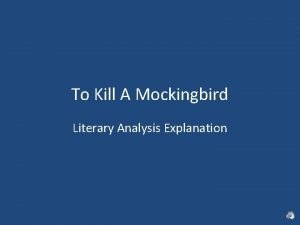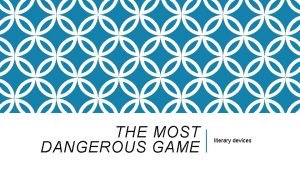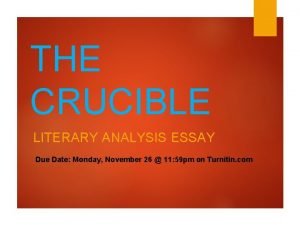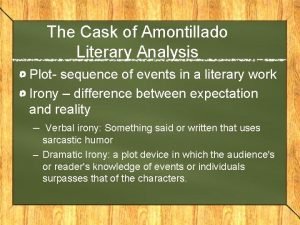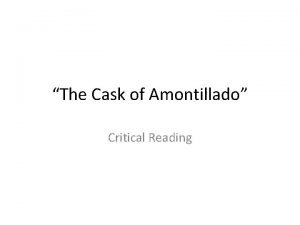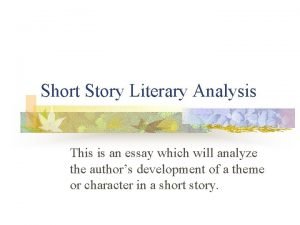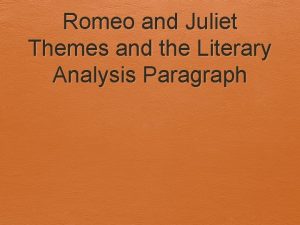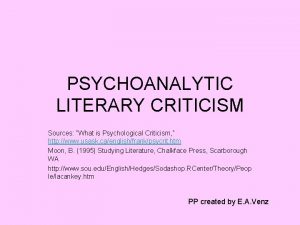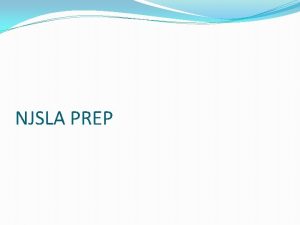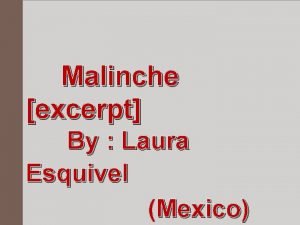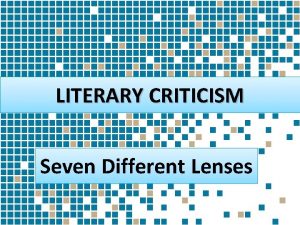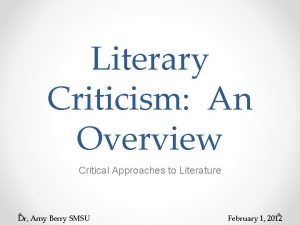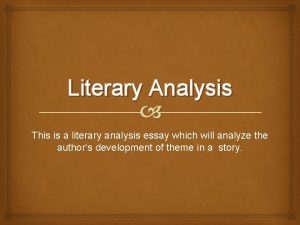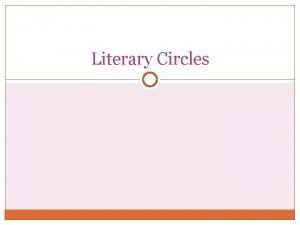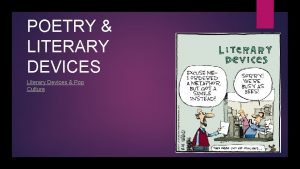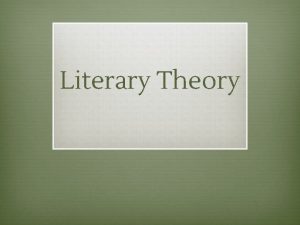What is Literary Analysis What is Literary Analysis
















- Slides: 16

What is Literary Analysis?

What is Literary Analysis? • It is analysis. • It is about literature. • It is an exploration of a piece of literature for a specific purpose. • Sometimes it involves RESEARCH of secondary sources.

What do I do? • Read a particular piece of literature, like a short • story, novella, novel, poem, or play. Look at one or more specified literary devices – elements of literature – – – Plot Character Theme Symbolism Conflict

You may also consider… • Figurative language • Irony • Setting • Historical connections • Societal connections • Point of view • Personal connections • others

What if I need help? • There are variety of handbooks written to help with literary analysis. • The internet can be a good source for viewing the literary analysis of others and for guides to literary analysis • And of course, you can always ask a teacher or librarian.

What is an Analysis? • An analysis of a literary work may discuss – Some element of a single piece of literature, such as: THEME, Characterization, Setting, point of view – Two different pieces of literature, comparing and contrasting, or looking at some particular element (as above) – The literary piece’s connection or comparison to some aspect of your world – social, political, economical, etc.

How do I define my PURPOSE? • Your purpose may be chosen for you (like • • discuss one THEME of a piece, or compare the story’s protagonist to someone in history, etc. ) You will identify this Purpose in your introductory paragraph in the THESIS Statement. AND then you will support or defend your purpose in your body paragraphs.

Which is the best Thesis (purpose) Statement? • One theme of The Old Man and the Sea is personal struggle. • The Old Man and the Sea is about an old man • and a fish. In The Old Man and the Sea, theme of personal struggle is demonstrated through the character of Santiago and his unyielding desire to bring the marlin home.

How do I support my thesis statement? • Examples from the text: – Direct quotations (word for word statements from the text) – Summaries of scenes (brief summaries of specific scenes) – Paraphrase (putting what the author says into your own words – effective with longer passages)

In some cases Secondary Sources are required and include: • Other critics’ opinions • Historical and social context • As you research Secondary Sources, it is important to read carefully and highlight useful passages and quotes. • NOTE: A writing assignment will specify the need for secondary sources.

What is a secondary source? • A book or article that discusses the specific text or texts you are exploring • A book are article which discusses the element or purpose you are exploring • A book or article that discusses the social and historical context of the text you are exploring

How and where do I find secondary sources? • Your local or school library – Reference books of Literary Criticisms – Data bases of Literary Criticisms – Literary periodicals • Online search engines • A bibliography that is part of your text • Ask a teacher or librarian

Incorporating QUOTES into your paper. • When you use primary or secondary sources, be • • sure to explain how they relate to your thesis Don’t simply “stick” a quote into your essay – incorporate it with your own words. Remember that this is your paper, your analysis —the primary and or secondary sources are just helping you support your thesis. Never, never plagiarize – take the words or ideas of another and use them as your own. You MUST credit your sources.

Internal Documentation: Primary Source • Whether you use direct (word for word quotes) or indirect quotes (paraphrasing), you must give credit to the SOURCE. – “Santiago struggled for hours, the sun burning his scalp and parching his lips” (Hemingway 89). Direct quote primary source. – The old man fought day after day, his lips parched and his hands worn and bleeding (Hemingway 91). Indirect quote primary source.

Secondary Sources • Whether you use direct (word for word quotes) or indirect quotes (paraphrasing), you must give credit to the SOURCE. – In his literary article about The Old Man and the Sea, John Doe state, “Santiago is the typical tragic hero” (68). Direct quote. – “Santiago is the typical tragic hero, ” and he is clearly destined to fail (Doe 68). Direct quote. – According to John Doe, Santiago is a tragic hero (68). Indirect quote.

Conclusion: Backfreaking https: //www. youtube. com/watch? v=V__y 7 4 Uvz. Yo – Video
 Poetic devices vs literary devices
Poetic devices vs literary devices To kill a mockingbird literary analysis prompts
To kill a mockingbird literary analysis prompts Examples of suspense in the most dangerous game
Examples of suspense in the most dangerous game Allegories in the crucible
Allegories in the crucible The cask of amontillado literary analysis
The cask of amontillado literary analysis Name three of the many clever things montresor
Name three of the many clever things montresor What is luchesi’s role in the story?
What is luchesi’s role in the story? Literary analysis example for a short story
Literary analysis example for a short story Romeo and juliet literary analysis
Romeo and juliet literary analysis Psychological criticism
Psychological criticism Njsla literary analysis
Njsla literary analysis Never let me go ruth
Never let me go ruth Malinche by laura esquivel excerpt
Malinche by laura esquivel excerpt Clincher examples
Clincher examples Literary analysis lenses
Literary analysis lenses Approaches in literary criticism
Approaches in literary criticism In a five paragraph literary analysis essay
In a five paragraph literary analysis essay

